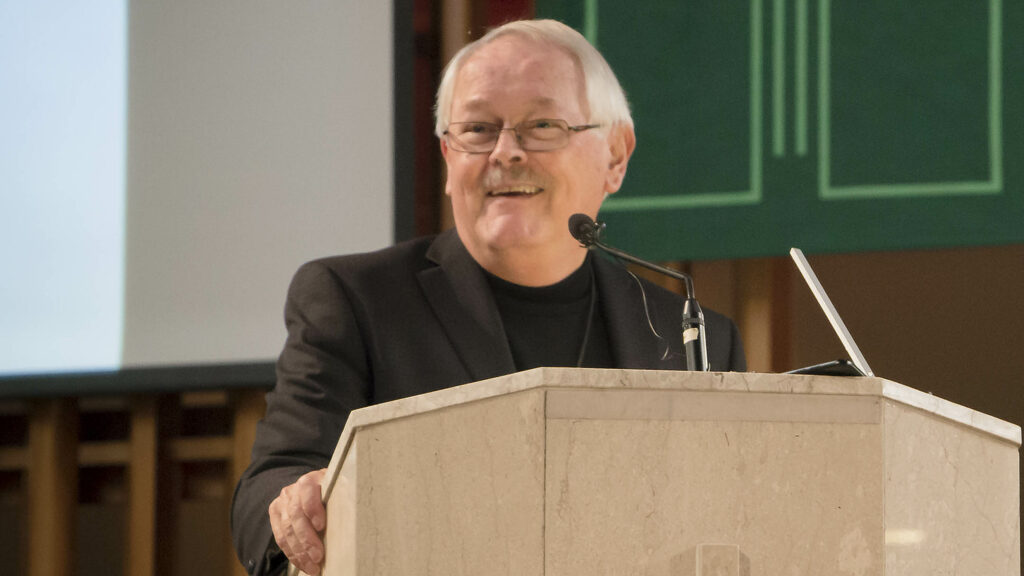The Gospel of John presents us with a very powerful and rather earthy mystical image: As John describes the Last Supper scene he tells us that as they were at table the beloved disciple was reclining with his head against Jesus’ breast.
The power of that image has, I believe, been better captured by artists than by theologians and biblical scholars. Artists and iconographers generally present the image to us in this way: The beloved disciple has his head leaning on Jesus’ breast in such a way that his ear is directly above Jesus’ heart but in such a way that his eyes are fixed outward looking at the world.
What a powerful image! If you put your ear at just the right place on someone’s chest you can hear that person’s heartbeat. The beloved disciple then is the one who is attuned to the heartbeat of God and is looking out at the world from that vintage point.
Further, John gives us a series of other images to flesh out the implications of hearing God’s heartbeat.
First, the beloved disciple stands with Jesus’ mother at the foot of the cross as Jesus is dying. What’s encapsulated in this image?
In Luke’s Gospel, Jesus admits that sometimes darkness seems to overpower grace and God seems powerless: Sometimes darkness just has its hour! His death was one of those hours and the beloved disciple, like Jesus’ mother, could do nothing other than stand in helplessness inside and beneath that darkness and injustice. There was nothing to be done but to stand inside the helplessness.
But, by standing there, the beloved disciple also stands in solidarity with the millions of poor and victimized all over the world who can do nothing against their plight. When one stands in helplessness when there’s nothing possible to be done one gives silent voice to human finitude, the deepest prayer possible at that moment. Then, afterwards, the beloved disciple takes the mother of Jesus into his home, an image that doesn’t need much elaboration.
However, a second image connected with the beloved disciple leaning on Jesus’ breast does need some elaboration: As the beloved disciple reclines on the breast of Jesus an interesting dialogue takes place: Jesus tells his disciples that one of them will betray him. Peter turns to the beloved disciple and says to him: “Ask him who it is?”
This begs the question: Why doesn’t Peter himself ask Jesus who it is who will betray him? Peter would not have been sitting so far away from Jesus as to not be able to ask the question himself.
Moreover Peter’s question takes on its real significance when seen in its historical context.
Scholars estimate that the Gospel of John was written somewhere between the years 90–100 AD. By then, Peter had been Pope and had been martyred. What the Gospel is suggesting here is that intimacy with Jesus trumps everything else, including ecclesial office, including being Pope. Everyone’s prayer has to go through the beloved disciple. The Pope cannot pray as Pope, but only pray as the beloved disciple (which, like any other Christian, he can be). He can offer prayers for the world and for the church as Pope, but he can pray personally only as beloved disciple.
Finally, the notion in the Gospel of John that intimacy with Jesus is more important the ecclesial office is further illustrated on the morning of the Resurrection.
Mary Magdala comes running from tomb and tells the disciples that the tomb is empty. Peter and the beloved disciple set off at once, running towards the tomb. We can easily guess who will arrive there first. The beloved disciple easily outruns Peter, not because he’s perhaps a younger man but because love outruns authority. The Pope can also get there first, if he runs as the beloved disciple rather than as a pope.
It is commonly assumed that the beloved disciple was the Evangelist himself, John. That may in fact be correct, but that is not what the Gospel text wants you to conclude. The historical identity of the beloved disciple is deliberately left an open question because the Gospel wants that concept, to be the beloved disciple of Jesus, to be a designation that beckons and fits you – and beckons and fits every Christian in the world, including, hopefully too, the Pope himself.
Who is the beloved disciple? The beloved disciple is any person, woman, man, or child who is intimate enough with Jesus so as to be attuned to the heartbeat of God and who then sees the world from that place of intimacy, prays from that place of intimacy, and sets off in love to seek the Risen Lord and grasp the meaning of his empty tomb.
Mystical images are best illuminated by other mystical images. With this in mind, I leave you with an image from the 4th century Desert Father, Evagrius of Pontus:
Breast of the Lord
Kingdom of God
Who rests against it
A theologian shall be.

